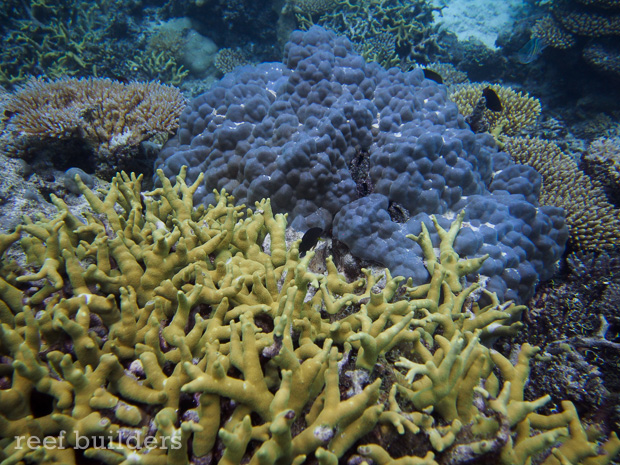Porites is among one of the first coral groups the budding stony coral reefers learn to identify but as recognizable as this genus is, Porites is much more ubiquitous on wild reefs than it is in our aquariums. Around the world Porites corals make up a big percentage of the coral cover found on certain reefs, and this corals’ dominance is well represented at Kwajalein Atoll in the Marshall Islands.
Particularly in the Pacific Ocean you can find the three most common types of Porites growth forms; branching, massive, and a combination of the two. Porites cylindrica is the quintessential branching Porites which is found in a grey and a bright yellow color, sometimes intermixed into sprawling fields of white or yellow fingers. Porites lutea is the cardholder for the most common species of massively growing Porites, with this species being often seen in yellow, light brown or a beautiful blueish purple. Just as we have chronicled in Mauritius, huge boulders of Porites in purple mounds abound on the reefs of Kwajalein.
By and large, the highly plastic growth form of Porites rus is the unofficial king of the Marshallese reefs, pccurring at every location and every depth, in a range of growth forms from massive to branching, plating to encrusting. As with the two preceding Porites species, P. rus also occurs in a yellow and a blueish grey, but the level of dominance that this species exhibits culminates into massive cathedrals of corals that create a heavenly backdrop for schools of graceful purple queen anthias, Pseudanthias tuka.
In addition to the inherent beauty each of these three types of Porites display, their sheer abundance in the Marshall Islands guarantees that at many points the different colors and different shapes meet each other in various ways to create endless fields of Porites reefs. Branching next to massive, yellow next to blue, and every combination in between means that Porites is one of the most important reef builders of south Pacific atolls and while we don’t have the space to enjoy these creations in our own aquariums, the following images reveal how gorgeous the merger of different of Porites corals appears in their natural environment.















